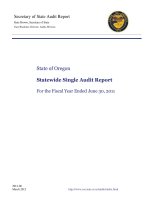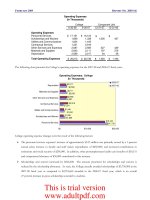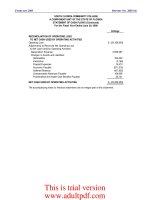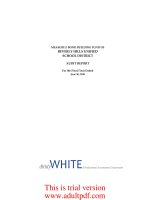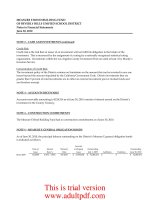REPORT NO. 2009-116 FEBRUARY 2009 SOUTH FLORIDA COMMUNITY COLLEGE Financial Audit For the Fiscal Year Ended June 30, 2008_part4 docx
Bạn đang xem bản rút gọn của tài liệu. Xem và tải ngay bản đầy đủ của tài liệu tại đây (229.42 KB, 8 trang )
FEBRUARY 2009 REPORT NO. 2009-116
SOUTH FLORIDA COMMUNITY COLLEGE
A COMPONENT UNIT OF THE STATE OF FLORIDA
NOTES TO FINANCIAL STATEMENTS (C
ONTINUED)
J
UNE 30, 2008
-27-
historical pattern of sharing of benefit costs between the employer and participating members. The
actuarial methods and assumptions used include techniques that are designed to reduce the effects of
short-term volatility in actuarial accrued liabilities and the actuarial value of assets, consistent with the
long-term perspective of the calculations.
The College’s initial OPEB actuarial valuation as of July 1, 2007, used the projected credit unit actuarial
method to estimate the unfunded actuarial liability as of June 30, 2008, and to estimate the 2007-08 fiscal
year annual required contribution. This method was selected because it is the same method used in the
private sector for determination of retiree medical liabilities. Because the OPEB liability is currently
unfunded, the actuarial assumptions included a 3 percent rate of return on invested assets, which is the
College’s expectation of investment returns under its investment policy. The actuarial assumptions also
included a payroll growth rate of 3 percent per year, and an annual health care cost trend rate of 9 percent
initially for the 2007-08 fiscal year, reduced by 1 percent per year for two years, then ½ percent per year
thereafter, to an ultimate rate of 5 percent after six years. The unfunded actuarial accrued liability is being
amortized as a level percent of payroll method amortized over 30 year. The remaining amortization period
at June 30, 2008, was 29 years.
13. RETIREMENT PROGRAMS
Florida Retirement System
. The Florida Retirement System (FRS) is primarily a State-administered,
cost-sharing, multiple-employer, defined-benefit retirement plan (Plan). FRS provisions are established by
Chapters 121 and 122, Florida Statutes; Chapter 112, Part IV, Florida Statutes; Chapter 238, Florida
Statutes; and Florida Retirement System Rules, Chapter 60S, Florida Administrative Code; wherein
eligibility, contributions, and benefits are defined and described in detail. Essentially all regular employees
of participating employers are eligible to enroll as members of the FRS.
Benefits in the Plan vest at 6 years of service. All members are eligible for normal retirement benefits at
age 62 or at any age after 30 years of service, which may include up to 4 years of credit for military service.
The Plan also includes an early retirement provision, but imposes a penalty for each year a member retires
before his or her normal retirement date. The Plan provides retirement, disability, death benefits, and
annual cost-of-living adjustments.
A Deferred Retirement Option Program (DROP) subject to provisions of Section 121.091, Florida
Statutes, permits employees eligible for normal retirement under the Plan to defer receipt of monthly
benefit payments while continuing employment with an FRS employer. An employee may participate in
This is trial version
www.adultpdf.com
FEBRUARY 2009 REPORT NO. 2009-116
SOUTH FLORIDA COMMUNITY COLLEGE
A COMPONENT UNIT OF THE STATE OF FLORIDA
NOTES TO FINANCIAL STATEMENTS (C
ONTINUED)
J
UNE 30, 2008
-28-
the DROP for a period not to exceed 60 months after electing to participate. During the period of DROP
participation, deferred monthly benefits are held in the FRS Trust Fund and accrue interest.
The State of Florida establishes contribution rates for participating employers. Contribution rates during
the 2007-08 fiscal year were as follows:
Class or Plan
Percent of Gross Salary
Employee Employer
(A)
Florida Retirement System, Regular
0.00 9.85
Florida Retirement System, Senior Management Service
0.00 13.12
Deferred Retirement Option Program - Applicable to
Members from All of the Above Classes or Plan
0.00 10.91
Florida Retirement System, Reemployed Retiree
(B) (B)
Notes:
(A)
(B)
Employer rates include 1.11 percent for the post-employment health
insurance subsidy. Also, employer rates, other than for DROP participants,
include .05 percent for administrative costs of the Public Employee Optional
Retirement Pro
g
ram.
Contribution rates are dependent upon retirement class or plan in which
reemployed.
The College’s liability for participation is limited to the payment of the required contribution at the rates
and frequencies established by law on future payrolls of the College. The College’s contributions for the
fiscal years ended June 30, 2006, June 30, 2007, and June 30, 2008, totaled $702,202, $915,575, and
$946,332, respectively, which were equal to the required contributions for each fiscal year.
Section 121.4501, Florida Statutes, provides for a Public Employee Optional Retirement Program
(PEORP). The PEORP is a defined-contribution plan alternative available to all FRS members in lieu of
the FRS defined-benefit plan. College employees already participating in the State Community College
System Optional Retirement Program or the DROP are not eligible to participate in this program.
Employer contributions are defined by law, but the ultimate benefit depends in part on the performance of
investment funds. The PEORP is funded by employer contributions that are based on salary and
membership class (Regular Class, Special Risk Class, etc.). Contributions are directed to individual member
accounts, and the individual members allocate contributions and account balances among various approved
investment choices. There were 70 College participants during the 2007-08 fiscal year. Required
contributions made to the PEORP totaled $192,400.
Financial statements and other supplementary information of the FRS are included in the State’s
Comprehensive Annual Financial Report, which is available from the Florida Department of Financial
Services. An annual report on the FRS, which includes its financial statements, required supplementary
This is trial version
www.adultpdf.com
FEBRUARY 2009 REPORT NO. 2009-116
SOUTH FLORIDA COMMUNITY COLLEGE
A COMPONENT UNIT OF THE STATE OF FLORIDA
NOTES TO FINANCIAL STATEMENTS (C
ONTINUED)
J
UNE 30, 2008
-29-
information, actuarial report, and other relevant information, is available from the Florida Department of
Management Services, Division of Retirement.
State Community College System Optional Retirement Program
. Section 1012.875, Florida Statutes,
provides for an Optional Retirement Program (Program) for eligible community college instructors and
administrators. The Program is designed to aid community colleges in recruiting employees by offering
more portability to employees not expected to remain in the FRS for six or more years.
The Program is a defined-contribution plan, which provides full and immediate vesting of all contributions
submitted to the participating companies on behalf of the participant. Employees in eligible positions can
make an irrevocable election to participate in the Program, rather than the FRS, and purchase retirement
and death benefits through contracts provided by certain insurance carriers. The employing community
college contributes, on behalf of the participant, 10.43 percent of the participant’s salary, less a small
amount used to cover administrative costs. The remaining contribution is invested in the company or
companies selected by the participant to create a fund for the purchase of annuities at retirement. The
participant may contribute, by payroll deduction, an amount not to exceed the percentage contributed by
the community college to the participant’s annuity account.
There were 12 College participants during the 2007-08 fiscal year. Required employer contributions made
to the Program totaled $77,348.
14. CONSTRUCTION COMMITMENTS
The College’s construction commitments at June 30, 2008, are as follows:
Project Description Total Completed Balance
Commitment to Date Committed
Renovation of Buildings F, C, C2, and T 3,271,043$ 3,096,918$ 174,125$
Renovation of Building A 11,500,000 134,754 11,365,246
Lake Placid Center - Retrofit 2,290,472 119,169 2,171,303
Highlands Campus - Parking Lot D 224,960 24,960 200,000
Total
17,286,475$ 3,375,801$ 13,910,674$
15. OPERATING LEASE COMMITMENTS
The College leased a mail machine and several copy machines under operating leases, with various
expiration dates through 2011. These leased assets and the related commitments are not reported on the
College’s statement of net assets. Operating lease payments are recorded as expenses when paid or
This is trial version
www.adultpdf.com
FEBRUARY 2009 REPORT NO. 2009-116
SOUTH FLORIDA COMMUNITY COLLEGE
A COMPONENT UNIT OF THE STATE OF FLORIDA
NOTES TO FINANCIAL STATEMENTS (C
ONTINUED)
J
UNE 30, 2008
-30-
incurred. Outstanding commitments resulting from these lease agreements are contingent upon future
appropriations. Future minimum lease commitments for noncancelable operating leases are as follows:
Fiscal Year Ending June 30 Amount
2009 69,251$
2010 56,953
2011 15,985
Total Minimum Payments Required 142,189$
16. RISK MANAGEMENT PROGRAMS
The College is exposed to various risks of loss related to torts; theft of, damage to, and destruction of
assets; errors and omissions; injuries to employees; and natural disasters. The College provided coverage
for these risks primarily through the Florida Community Colleges Risk Management Consortium
(Consortium), which was created under authority of Section 1001.64(27), Florida Statutes, by the boards of
trustees of the Florida public colleges for the purpose of joining a cooperative effort to develop,
implement, and participate in a coordinated Statewide College risk management program. The Consortium
is self-sustaining through member assessments (premiums) and is reinsured through commercial
companies for claims in excess of specified amounts. Reinsurance from commercial companies provided
excess coverage of up to $115 million through February 29, 2008, and up to $200 million effective
March 1, 2008. Insurance coverage obtained through the Consortium included health and hospitalization,
life, dental, long-term disability, fire and extended property, general and automobile liability, workers’
compensation, and other liability coverage. Settled claims resulting from these risks have not exceeded
coverage in any of the past three fiscal years.
Board member bonds, coverage for the trucks and trailers used in the truck-driving classes offered by the
College, and bonds for employees who are notaries are being provided through purchased commercial
insurance with minimum deductibles for each line of coverage.
17. SCHEDULE OF STATE REVENUE SOURCES
Revenue from State sources for current operations is primarily from the Community College Program
Fund administered by the Florida Department of Education under the provisions of Section 1011.81,
Florida Statutes. In accordance with Section 1011.84, Florida Statutes, the Legislature determines each
colleges’ apportionment considering the following components: base budget, which includes the State
appropriation to the Community College Program Fund in the current year plus the related student tuition
and fees assigned in the current General Appropriations Act; the cost-to-continue allocation, which
This is trial version
www.adultpdf.com
FEBRUARY 2009 REPORT NO. 2009-116
SOUTH FLORIDA COMMUNITY COLLEGE
A COMPONENT UNIT OF THE STATE OF FLORIDA
NOTES TO FINANCIAL STATEMENTS (C
ONTINUED)
J
UNE 30, 2008
-31-
consists of incremental changes to the base budget, including salaries, price levels, and other related costs;
enrollment workload adjustments; operation costs of new facilities adjustments; and new and improved
program enhancements, which are determined by the Legislature. Student fees in the base budget plus
student fee revenues generated by increases in fee rates are deducted from the sum of these components to
determine the net annual State apportionment to each college.
The State allocates gross receipts taxes, generally known as Public Education Capital Outlay money, to the
College on an annual basis. The College is authorized to receive and expend these resources only upon
applying for and receiving an encumbrance authorization from the Florida Department of Education.
The following is a summary of State revenue sources and amounts:
Source Amount
Community College Program Fund 15,299,168$
Gross Receipts Tax (Public Education Capital Outlay) 7,063,827
1,624,117
Other State Sources 1,007,842
Bright Futures Scholarship Program 462,548
Florida Student Assistance Grants 458,406
Restricted Contracts and Grants 308,529
Performance Based Incentives 175,832
Motor Vehicle License Tax (Capital Outlay and Debt Service) 142,825
Total
26,543,094$
Education Enhancement Trust Fund (Lottery)
18. FUNCTIONAL DISTRIBUTION OF OPERATING EXPENSES
The functional classification of an operating expense (instruction, academic support, etc.) is assigned to a
department based on the nature of the activity, which represents the material portion of the activity
attributable to the department. For example, activities of an academic department for which the primary
departmental function is instruction may include some activities other than direct instruction such as public
service. However, when the primary mission of the department consists of instructional program
elements, all expenses of the department are reported under the instruction classification. The operating
expenses on the statement of revenues, expenses, and changes in net assets are presented by natural
classifications. The following are those same expenses presented in functional classifications as
recommended by NACUBO:
This is trial version
www.adultpdf.com
FEBRUARY 2009 REPORT NO. 2009-116
SOUTH FLORIDA COMMUNITY COLLEGE
A COMPONENT UNIT OF THE STATE OF FLORIDA
NOTES TO FINANCIAL STATEMENTS (C
ONTINUED)
J
UNE 30, 2008
-32-
Functional Classification Amount
Instruction 8,600,976$
Academic Support 2,632,346
Student Services 3,377,930
Institutional Support 4,262,346
Operation and Maintenance of Plant 4,452,450
Scholarships and Fellowships 1,674,995
Depreciation 2,569,087
Auxiliary Enterprises 1,643,302
Total Operating Expenses
29,213,432$
This is trial version
www.adultpdf.com
FEBRUARY 2009 REPORT NO. 2009-116
-33-
AUDITOR GENERAL
STATE OF FLORIDA
G74 Claude Pepper Building
111 West Madison Street
Tallahassee, Florida 32399-1450
The President of the Senate, the Speaker of the
House of Representatives, and the
Legislative Auditing Committee
INDEPENDENT AUDITOR’S REPORT ON INTERNAL CONTROL OVER
FINANCIAL REPORTING AND ON COMPLIANCE AND OTHER MATTERS
BASED ON AN AUDIT OF THE FINANCIAL STATEMENTS PERFORMED
IN ACCORDANCE WITH
GOVERNMENT AUDITING STANDARDS
We have audited the financial statements of South Florida Community College, a component unit of the State of
Florida, and its discretely presented component unit as of and for the fiscal year ended June 30, 2008, which
collectively comprise the College’s basic financial statements, and have issued our report thereon included under the
heading INDEPENDENT AUDITOR’S REPORT ON FINANCIAL STATEMENTS. Our report on the
financial statements was modified to include a reference to other auditors. We conducted our audit in accordance
with auditing standards generally accepted in the United States of America and the standards applicable to financial
audits contained in Government Auditing Standards issued by the Comptroller General of the United States. Other
auditors audited the financial statements of the discretely presented component unit as described in our report on
the College’s financial statements. This report does not include the results of the other auditors’ testing of internal
control over financial reporting or compliance and other matters that are reported on separately by those auditors.
Internal Control Over Financial Reporting
In planning and performing our audit, we considered the College’s internal control over financial reporting as a basis
for designing our auditing procedures for the purpose of expressing our opinions on the financial statements, but
not for the purpose of expressing an opinion on the effectiveness of the College’s internal control over financial
reporting. Accordingly, we do not express an opinion on the effectiveness of the College’s internal control over
financial reporting.
A control deficiency exists when the design or operation of a control does not allow management or employees, in the
normal course of performing their assigned functions, to prevent or detect misstatements on a timely basis. A
significant deficiency is a control deficiency, or combination of control deficiencies, that adversely affects the College’s
ability to initiate, authorize, record, process, or report financial data reliably in accordance with generally accepted
DAVID W. MARTIN, CP
A
AUDITOR GENERAL
PHONE: 850-488-5534
FAX: 850-488-6975
This is trial version
www.adultpdf.com
FEBRUARY 2009 REPORT NO. 2009-116
-34-
accounting principles such that there is more than a remote likelihood that a misstatement of the College’s financial
statements that is more than inconsequential will not be prevented or detected by the College’s internal control.
A material weakness is a significant deficiency, or combination of significant deficiencies, that results in more than a
remote likelihood that a material misstatement of the financial statements will not be prevented or detected by the
College’s internal control.
Our consideration of internal control over financial reporting was for the limited purpose described in the first
paragraph of this section and would not necessarily identify all deficiencies in internal control that might be
significant deficiencies or material weaknesses. We did not identify any deficiencies in internal control over financial
reporting that we consider to be material weaknesses, as defined above.
Compliance and Other Matters
As part of obtaining reasonable assurance about whether the College’s financial statements are free of material
misstatement, we performed tests of its compliance with certain provisions of laws, rules, regulations, contracts, and
grant agreements, noncompliance with which could have a direct and material effect on the determination of
financial statement amounts. However, providing an opinion on compliance with those provisions was not an
objective of our audit and, accordingly, we do not express such an opinion. The results of our tests disclosed no
instances of noncompliance or other matters that are required to be reported under Government Auditing Standards.
Pursuant to Section 11.45(4), Florida Statutes, this report is a public record and its distribution is not limited.
Auditing standards generally accepted in the United States of America require us to indicate that this report is
intended solely for the information and use of the Legislative Auditing Committee, members of the Florida Senate
and the Florida House of Representatives, Federal and other granting agencies, and applicable management and is
not intended to be and should not be used by anyone other than these specified parties.
Respectfully submitted,
David W. Martin, CPA
February 9, 2009
This is trial version
www.adultpdf.com
